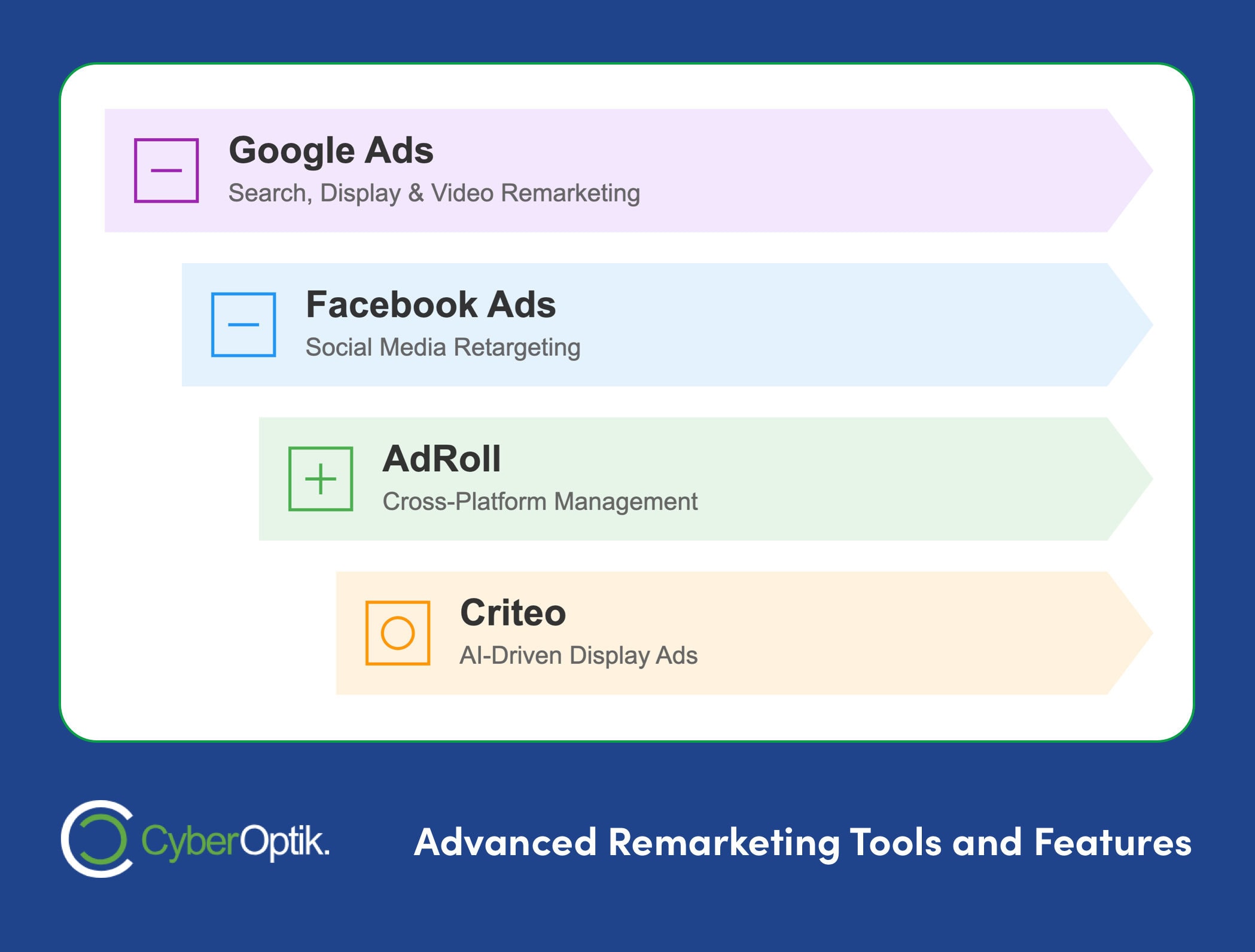Remarketing has transformed from a basic advertising strategy into a sophisticated tool that combines advanced data analysis, cutting-edge technology, and a nuanced understanding of customer behavior.
Gone are the days of relying solely on simple cookie-based ads that followed users around the web.
Today’s remarketing leverages first-party data, artificial intelligence, and cross-device tracking to create campaigns that not only re-engage potential customers but also deliver tailored experiences that resonate on a personal level.
Why does this matter? The landscape of digital advertising is shifting rapidly, with privacy concerns, technological advancements, and customer expectations driving the need for smarter strategies.
By adopting advanced remarketing techniques, businesses can achieve remarkable results, such as boosting conversions by up to 50% with tools like Google’s Optimized Targeting and significantly increasing ROI by creating personalized interactions that deepen customer relationships.
To succeed, you need to go beyond the basics. Here’s an overview of the key strategies and tools shaping the future of remarketing:
- Key Strategies:
- Smart audience targeting using behavioral data
- Building highly specific target groups that align with your goals
- Cross-device remarketing to maintain consistency across all customer touchpoints
- Top Tools:
- Google Ads for its robust search and display capabilities
- Facebook Ads for detailed audience segmentation
- AdRoll for managing budgets and tracking results across platforms
- Criteo for AI-driven display ads and dynamic retargeting

Setting up a successful campaign means going beyond merely placing ads. It requires thoughtful implementation of tracking systems like Google Tag Manager, adopting server-side tracking to balance privacy and precision, and managing ad frequency to avoid overwhelming users while staying top of mind.
Additionally, continuous improvement is key. By monitoring critical metrics like click-through rate (CTR), cost per acquisition (CPA), return on ad spend (ROAS), and conversion rates, and by conducting A/B testing regularly, you can refine your campaigns to achieve peak performance.
Adhering to regulations such as GDPR and CCPA is not just about compliance—it’s about earning customer trust. Transparency, ethical data use, and offering easy opt-out options are essential in today’s environment.
The future of remarketing lies in creating meaningful connections with your audience, not simply increasing ad impressions. By focusing on first-party data and contextual targeting, businesses can thrive even as the digital world moves toward a cookieless future.
Advanced Retargeting Strategies for Facebook and Google Ads
Advanced Retargeting Strategies for Facebook and Google Ads
Smart Audience Targeting
Smart audience targeting takes remarketing up a notch. It’s not just about showing ads to site visitors. It’s about using data and tech to hit the right people at the right time.
Using Customer Behavior Data
Customer behavior data is marketing gold. It shows what people like and how they interact with your brand.
Orbitz found Mac users spend up to 30% more per night on hotels than PC users. So, they started showing pricier hotels to Mac users. Smart move.
But it’s not just about devices. It’s about actions. A gift basket company tracked two customers: Christy and Zara. Christy always bought gifts early. Zara was a last-minute shopper. The company sent Christy promos months before holidays, and Zara got reminders just before special dates.
Building Target Groups
Building specific target groups is crucial. It’s about creating groups that align with your business goals.
The World Wildlife Fund (WWF) used Meltwater to identify five categories of influencers. Result? A 12x increase in followers and 1.9 million Twitter impressions. That’s the power of targeted groups.
Here’s how to build effective target groups:
- Use your data: Look for patterns in your customer data.
- Create segments: Group customers with similar behaviors or traits.
- Test and refine: Start broad, then narrow down based on results.
The goal? Create groups that respond similarly to your marketing. This makes your campaigns more effective and efficient.
Following Users Across Devices
People use multiple devices. Your marketing needs to keep up.
The Mobile Marketing Association says 80% of millennials shopping online “follow a cross-device path to purchase.” They might start on their phone, continue on their laptop, and buy on their tablet.
Google’s cross-device remarketing helps with this. It lets you show ads to visitors across any device linked to their Google account. This feature, launched in May 2017, changed the game for marketers.
Why it matters:
- You can keep your brand message consistent across all devices.
- Users who see ads on multiple devices have conversion rates 230% higher than average.
- IRI Global Products reported that cross-channel techniques can increase Return on Ad Spend (ROAS) by 30-70%.
To make the most of cross-device targeting:
- Enable remarketing in your Google Analytics account.
- Update your privacy policy to reflect this new targeting method.
- Create ads that work well on all devices – mobile, tablet, and desktop.
Top Remarketing Tools
Let’s dive into some of the best tools that can supercharge your retargeting efforts.
Big Business Solutions
For the big players running complex campaigns, these robust platforms stand out:
Google Ads: It’s the go-to for search, display, YouTube, and Discovery network advertising. How does it work? You bid on keywords, and Google shows your ads to users with matching search queries. It’s like fishing where the fish are biting.
Facebook Ads: This platform is all about user data. It lets you target ads across Facebook, Instagram, and a network of mobile apps. Want to boost brand awareness through social media? Facebook Ads is your friend. You can choose from image ads, video ads, carousel ads, and more.
AdRoll: One of the OGs in retargeting, AdRoll has been around for almost 20 years. Its strength? Letting you manage budgets and track results across multiple platforms in one place. Ecommerce businesses love it for its dynamic retargeting ad templates.
Criteo: Think of Criteo as your all-in-one ad management platform. From customer acquisition to video ads and dynamic retargeting, it does it all. It taps into a network of over 1,000 premium publishers with 750+ million daily users. The cherry on top? AI-powered automated display ads and video retargeting.
Connecting with CRM Systems
Want to make your remarketing campaigns smarter? Hook them up with your CRM data. Here’s how some tools are making it happen:
HubSpot Marketing: This tool brings together CRM and marketing in one package. You get email marketing, social media management, and marketing automation. The result? More personalized, targeted remarketing campaigns based on detailed customer data.
Tool Comparison Guide
Choosing a remarketing tool? Here’s a quick comparison to help you out:
| Tool | Best For | Key Features | Average CPC |
|---|---|---|---|
| Google Ads | Intent-based advertising | Keyword targeting, PPC model | $2.69 |
| Facebook Ads | Social media engagement | Detailed audience targeting, Various ad formats | $1.72 |
| AdRoll | Cross-platform management | Centralized dashboard, Dynamic retargeting | Varies |
| Criteo | AI-powered advertising | Automated display ads, Large publisher network | Varies |
| HubSpot Marketing | CRM integration | Comprehensive marketing tools, Personalization | Varies |
Keep in mind, these tools might perform differently depending on your industry and specific needs. It’s often worth testing a few to see what works best for you.
“The additional data about the customers and the results of RFM analysis can be sent into Google Analytics 4 and used to create new custom reports, segments, and remarketing audiences.” – Ievgen Krasovytskyi, Head of Marketing at OWOX
This quote highlights a key point: integrating your remarketing tools with your analytics can lead to more insightful campaigns. It’s not just about using the tools, but using them smartly.
Setting Up Your Campaign
Let’s break down how to set up an advanced remarketing campaign that gets results.
Tracking Code Setup
Good tracking is key. Here’s how to set it up with Google Tag Manager (GTM):
- Make a GTM container for your site
- Add the Google Ads Remarketing tag
- Create a variable for your Google Ads Conversion ID
- Use an “All Pages” trigger
Don’t forget to track specific actions. For example, if you run an online store, track when people view products, add to cart, and buy.
Server Tracking Methods
With privacy concerns growing, server-side tracking is becoming a big deal. It’s more accurate, private, and less affected by ad blockers.
Google’s server-side tagging is a game-changer. Here’s how to use it:
- Set up a server Google Tag Manager container
- Use a custom domain for your tagging server
- Make sure the tagging server URL matches your website’s domain
“Server-side tracking improves data accuracy, privacy compliance, extends cookie lifespans, and reduces ad blockers’ impact.” – Analyzify
This approach gets you ready for a future without cookies. Chrome will start limiting third-party cookies for some users in 2024, and for everyone by 2025. Using server-side tracking now puts you ahead of the game.
Managing Ad Frequency
You want people to see your ads, but not so much that they get annoyed. That’s where frequency capping comes in.
Here’s how to do it:
- Start small: Limit ads to 3-4 times per day
- Watch your numbers: Keep an eye on click-through rates and conversions
- Adjust as needed: If people are engaging without getting tired of your ads, you can show them more often
For remarketing, you can be a bit more aggressive. Showing ads 5 to 7 times per hour can keep your brand in mind for interested users without being too much.
| Campaign Type | How Often to Show Ads |
|---|---|
| Brand Awareness | 2 times per week for 10 weeks |
| Retargeting | 5-10 times per month |
| Aggressive Remarketing | 5-7 times per hour |
Making Campaigns Work Better
Want to crush it with advanced remarketing? You need to measure, test, and tweak your campaigns like a pro. Let’s dive in.
Measuring Results
Tracking the right stuff is key. Here are the numbers you should care about:
- Click-through rate (CTR): How many people click your ads? Higher is better.
- Cost per acquisition (CPA): How much do you spend to get a customer? Lower is better.
- Return on ad spend (ROAS): How much money do you make for every ad dollar? Higher is better.
- Conversion rate (CR): How many clickers become customers? Higher is better.
Here’s the deal: Don’t look at these numbers alone. Mix CTR with conversion rate, ROAS, and customer lifetime value. That’s how you see the big picture.
Testing What Works
A/B testing is your secret weapon. Here’s how to do it right:
- Never stop testing: Keep learning what your audience likes. It keeps your ads fresh.
- Change one thing at a time: This way, you know exactly what’s working (or not).
- Be patient: Let your tests run for at least a week. You need solid data.
- Crunch the numbers carefully: Use A/B test calculators. Don’t jump to conclusions without proof.
Check out this real-world win:
Underoutfit tested user-generated videos on Facebook Ads. The result? Branded content ads crushed it: 47% higher click-through rate, 31% lower cost per sale, and 38% higher return on ad spend compared to regular ads.
Success Metrics Guide

Want to supercharge your remarketing? Focus on these numbers:
- Click-through rate (CTR)
Shoot for the industry average or higher. To boost it, make your ads pop with killer copy and visuals.
- Conversion rate (CR)
Aim for 2-5% in most industries. To improve, make your landing pages and offers irresistible.
- Cost per acquisition (CPA)
Keep it lower than what an average customer spends. Sharpen your audience targeting and bidding to bring it down.
- Return on ad spend (ROAS)
Go for at least 4:1 ($4 back for every $1 spent). Focus on high-value customers and think long-term.
- Customer retention rate (CRR)
Shoot for 60% or higher. Make your customer experience awesome and consider loyalty programs.
Here’s the thing: These numbers are all connected. Boost your CTR, and you might see your CPA drop and ROAS climb. Always look at the whole picture when fine-tuning your campaigns.
Privacy Rules and Laws
As remarketing gets smarter, privacy laws get tougher. Let’s look at what’s happening and how to play by the rules.
Privacy Law Basics
Two big laws are shaking things up: GDPR in the EU and CCPA in the US. Here’s the scoop:
GDPR: It’s the strict one. You need a clear “yes” from people before using their data for remarketing. No sneaky stuff allowed.
CCPA: It’s a bit easier. You can collect data, but you have to let California folks know and give them a way to opt out.
Here’s how they stack up:
| Feature | GDPR | CCPA |
|---|---|---|
| Consent | Must get a "yes" | Can collect unless they say "no" |
| Who it covers | EU residents | California residents |
| Fines | Up to €20 million or 4% of global turnover | Up to $7,500 per intentional violation |
But don’t think you’re safe if you’re not in these places. Ryan Robinson, a big-name blogger, says:
“Following GDPR rules shows you respect people’s rights and collect data ethically.”
In other words, it’s just good business to follow these rules, no matter where you are.
Getting Ready for New Rules
Privacy laws are changing fast. Here’s how to stay on top:
- Be clear: Update your privacy policy. Tell people how you use their data for remarketing. Keep it simple.
- Ask nicely: When you want to use someone’s data, ask in a way that’s easy to understand. A Pew Research Center study found that 81% of people think data collection is more risky than helpful. So, earn their trust.
- Make it easy to say no: Give people a simple way to opt out of remarketing. It builds trust and keeps you on the right side of the law.
- Use smart tools: A Customer Data Platform (CDP) can help you manage data the right way. It makes it easier to group and analyze data while following the rules.
- Check yourself: Laws change. Your business changes. Make sure you’re still following the rules by checking regularly.
One online store (they wanted to stay anonymous) changed their whole remarketing approach to focus on getting permission. They set up a system to ask for and manage user permissions. The result? They followed GDPR rules AND their ads worked better. Turns out, people like ads more when they’ve said it’s okay to see them.
Remember, following privacy rules isn’t just about avoiding fines. It’s about building trust with your customers. Gordon Daniell from Kentico puts it well:
“If customers know you’re collecting data, why you’re doing it, and they feel okay about it, they’re more likely to stick around and keep buying. They won’t run away when they see a targeted ad.”
Wrap-Up
Advanced remarketing has changed how businesses reconnect with their audience. Here’s what you need to know:
Key Points
Make it personal: Forget generic ads. Advanced remarketing lets you customize your message based on how people interact with your site. Yorkshire Building Society found that women aged 45-59 responded best to their campaigns. That’s the kind of insight that can sharpen your approach.
Use multiple channels: Don’t stick to just one platform. Speakeasy of Strength mixes Nextdoor, YouTube videos, and text messaging to reach potential customers. It’s about being where your audience is.
Let data guide you: Analytics are your friend. Outbrain creates separate remarketing lists for users who spend four minutes on their site. Why? They know these visitors are more likely to convert.
Respect privacy: With GDPR and CCPA, you need to be upfront about how you use data. Update your privacy policy and make it easy for people to opt out. It’s not just about following rules – it’s about building trust.
Keep improving: The digital world doesn’t stand still, and neither should you. Keep testing and analyzing your results. As Tara West from Koozai puts it: “Remarketing reinforces your brand to previous visitors and helps drive conversions.”
Advanced remarketing isn’t just about showing more ads. It’s about creating meaningful connections that get results. Use these strategies, and you could see engagement jump by 161% and costs per order drop by up to 43%.
Looking ahead, we’re moving towards a cookieless future. This means first-party data and contextual targeting will become even more important. Start adapting now, and you’ll be ready for whatever comes next in digital marketing.




